The Padma was wide even at this dry season. We found a fish-market on the sandy bank. Fish was brought in by numerous boats, and sold here for the markets in Dhaka. Children were playing everywhere. Mawa village lay next to the market, with narrow lanes and tin-roof houses.
From Mawa we drove to the ancestral home of (late) Sir Jagadish Chandra Bose - one of Indian subcontinent's most eminent scientists - in Dohar. Sir Bose invented wireless radio (local lore claims he divulged his findings to Marconi who walked off with the credits). He was also a great botanist, the first to prove conclusively that plants have lives.
Sir Bose's home is over many acres of land, and includes several buildings, ponds, orchards, etc. It has been converted into various schools and living quarters for school employees. Though there were statues and pictures of him, we found no documentation or introduction to his work. Sad.
From there we visited the old mansion of a (Hindu) Zaminder with directions from a local acquaintance. We found the palace to be in poor repair. Some remnants pointed to the glory of old days, including ancient broken water pumps that ran on diesel and pumped water up to a rooftop tank so the Zamindar family could take showers. I am not sure who owns the property now. In fact, I could not even find the name of the original Zaminder.
Then it was off to nearby Bhagyakul market where my companions tasted the famous local "maaTha" - a lemony, sweetened yogurt drink. I abstained for bacteriophobic reasons, but relented in the end. A sip of the drink was delicious, not as thick as Lassi, but made invigorating by fresh lemon juice.
We returned home by noon. Thanks to Dr. Zia for showing me these places. Now the pictures.
The Famous Hilsa Fish of the Padma
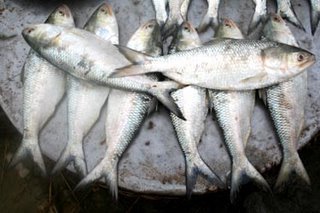
Boats on the Padma
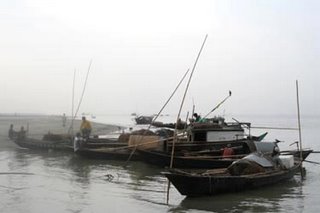
Dad feeding coconut-water to kid

Man with suitcase and fish
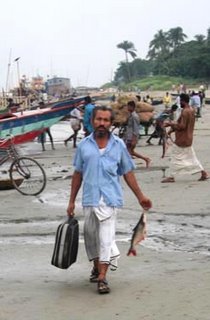
Boy who works on a boat

Windows in Mawa village

Girl with doll on riverbank

Cute kid at Mawa village

Entrance to JC Bose's home
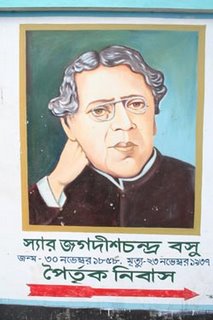
Compound of one building in JC Bose's home

Drying clothes on roof of JC Bose's home

Roof-antennas in the house where the man who invented wireless radio once lived:

Jarul flowers in another building in JC Bose home:
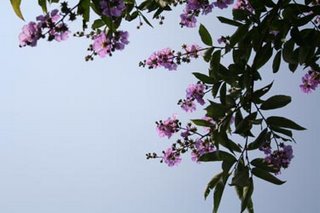
A hijol tree on the pond; hijol's decomposed bark is good fish food:

Old Zamindar mansion
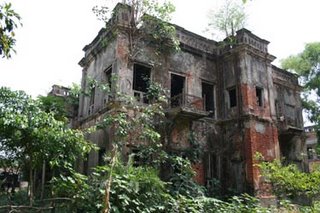
Pond belonging to Zamindar home

Kids climbed this tree for its flower

7 comments:
I think you have one misconception that AJC Bose's work on Radio was a lore. It's not true. IEEE writes :
"During the years 1894-1900, Bose performed pioneering research on radio waves and created waves as short as 5 mm. Bose’s work actually predates that of Guglielmo Marconi who is most often associated with the development of radio. Unlike Marconi who sought to commercialize his work with radio waves, Bose was purely interested in radio waves as a scientific endeavor."
http://www.ieee-virtual-museum.org/collection/people.php?id=1234735&lid=1
Nowadays, we regard JC Bose as the inventor of Radio.
From dictionary.com, "lore":
1. Accumulated facts, traditions, or beliefs about a particular subject. See Synonyms at knowledge.
2. Knowledge acquired through education or experience.
You've written :
"local lore claims he divulged his findings to Marconi who walked off with the credits".
My point was it is no longer a local lore - i.e. not a "local" belief/knowledge. It is now accepted by IEEE also.
Then you should have emphasized "local" in your first comment. I don't see that word in there.
Nevertheless, this is a good point, glad that he is getting the recognition he deserved.
I believe JC Bose is one of the most under recognized inventors in the history of science.
What also saddens me is the way we are allowing the abuse of these great historical sites. These structures must be protected national historical sites. Not somebodies living quarters.
Recently I wrote about another great man of the same locality in this post
http://www.drishtipat.org/blog/2006/02/16/195/
"From there we visited the old mansion of a (Hindu) Zaminder with directions from a local acquaintance. We found the palace to be in poor repair. Some remnants pointed to the glory of old days, including ancient broken water pumps that ran on diesel and pumped water up to a rooftop tank so the Zamindar family could take showers. I am not sure who owns the property now. In fact, I could not even find the name of the original Zaminder."
If its near Bhagyakul, I think it might belong to the Roy's, who relocated to India after the partition. I am writing an article on this family on wikipedia and would be grateful if you provide me with more info, pictures of bhagyakul and the zamindari buildings you saw there.
Chayan, please send me email at my yahoo address (ihtishamkabir).
Post a Comment